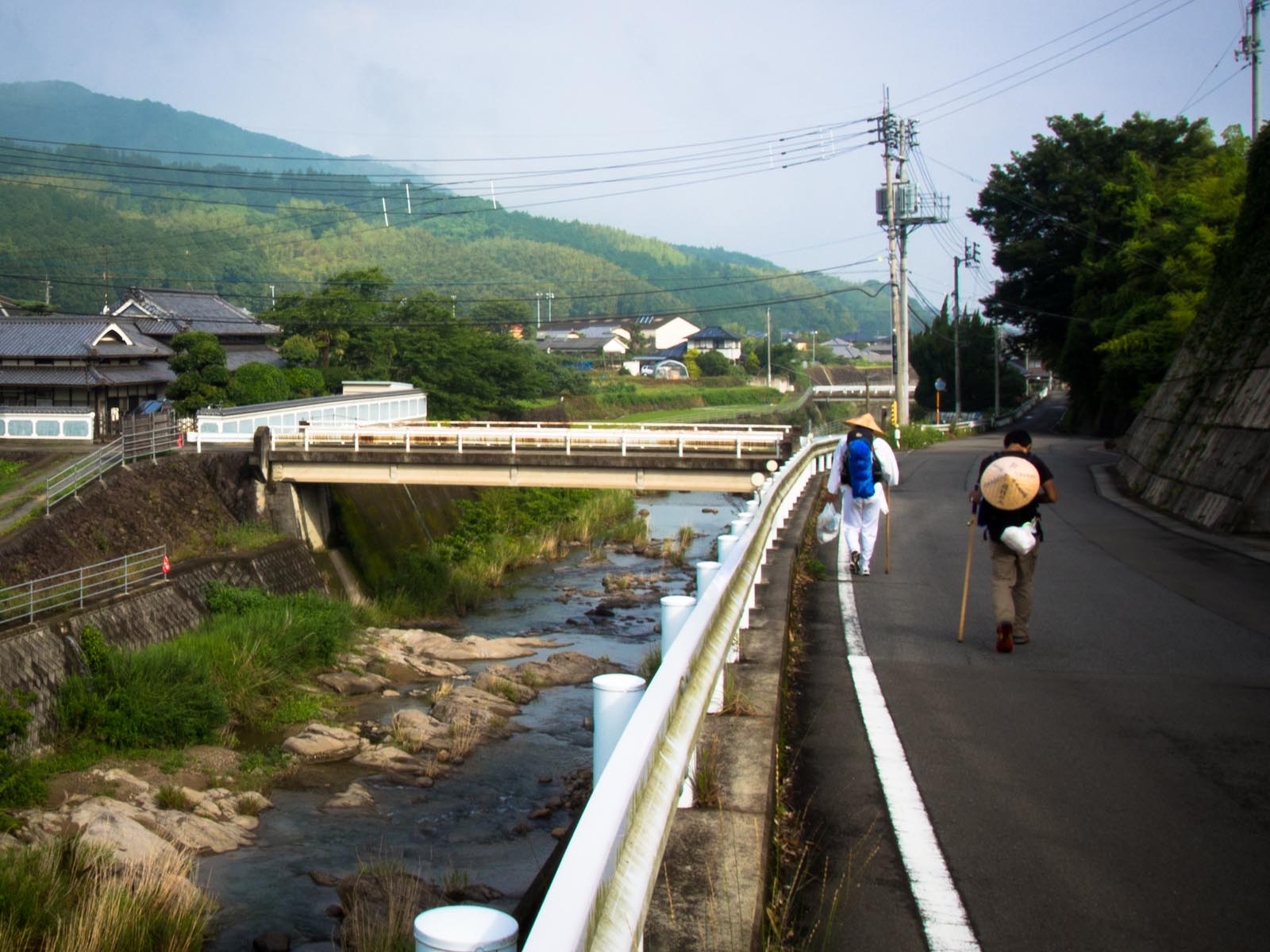What to Bring on the Shikoku Pilgrimage
Recommended General Packing List
There are many ways to complete the Shikoku Pilgrimage. Some walk, in line with pilgrimage tradition. Others go by bicycle, car/motorcycle, or bus tour. No matter your mode of transportation, there are some universal items we recommend you bring as part of your journey.
Note to walking pilgrims: Whatever a walking pilgrim brings with them will be on their back for one to two months. It is crucial that they carry only the bare necessities. A typical superpower that a long trekker will develop is a hypersensitivy to lugged weight - it is not uncommon for walking pilgrims to mail home unused books, clothes, electronics, and more in their first or second week.
Basic Gear
Pilgrim Attire
Pilgrim Supplies
Guides and Maps
The above website delivers only within Japan, but you can purchase the English version of the most popular route guide on Amazon. Guides are also available for purchase at the following temples: 1, 6, 10, 21, 24, 26, 37, 40, 51, 54, and 75.
Clothing
Because many paid lodgings have washing machines and dryers, and laundromats can be found in most towns, most pilgrims need no more than 3-4 sets of clothing.
Your clothing should be machine-washable. Plain light clothing is ideal for the hot and sunny days as it reflects more sunlight.
- 3-4 sets of outfits: tops, pants, and underwear Tops: During warmer months, T-shirts are most common, but tanktops are also great, and will free you of visible pit stains. Many pilgrims also opt to protect their shoulders and arms with the traditional white pilgrim jacket (“hakui,” 白衣)
- Jacket/appropriate outerwear for the season Even during warm summer months, a light jacket is still recommended for the cool nights, on rainy days, or at high elevations. If you are committed to traveling light, consider buying a jacket specifically made for hiking or trekking, or lightweight down jackets that can be compacted into travel-friendly pouches.
- Rain jacket/poncho
- Bandana (“hachimaki,” 鉢巻) For pilgrims planning to wear the traditional hat (“sugegasa,” 菅笠), you’ll need a bandana underneath. These are also great for keeping sweat from dripping down your face. They take up so little space that it’s worthwhile to bring two or more.
- Boots/trekking shoes
- Sunglasses
Socks: Normal socks (ankle-length or above ankle) are fine, but consider wearing Japan’s own amazing five-toed socks (look for 五本指靴下 or 五本指ソックス). They take a little longer to put on since each toe gets its own pocket, but for outdoor activities that require extensive walking, 5-toed socks eliminate friction between the skin of your toes and can save you from potential blisters.

Invest in a breathable rain jacket. I made the grave mistake of buying a regular poncho from the ¥100 store in Japan, and began sweating profusely minutes after putting it on. For those on a tight budget, Temple 1 offers a sturdy plastic raincoat for about ¥2,000. If you will be wearing the pilgrim hat (sugegasa), make sure it also comes with a plastic cover for the rain.
Electronics
- Phone
- Camera
- Extra camera battery and SD cards
- Chargers Type A outlets (two-prong plugs) are the standard in Japan, though some places may carry Type B (with an extra ground pin).
- Pocket WIFI (optional)
Documents
- Passport
- Photocopies of passport
- Credit cards
- Cash/ATM card Japan is known for being a largely cash-based society. This is doubly true in Shikoku, where you will be hard-pressed to find vendors that accepts credit cards outside of business hotels in the larger cities. On this pilgrimage, cash is king.
- Driver’s liscense/international license
- Travel insurance card
- Train card (IC card)
- Notebook/journal and some pens/pencils
Medical Supplies
- Sunscreen
- Chapstick/lip balm
- Basic first aid kit
- Tools and products to treat blisters (especially for walking pilgrims) Almost every walking pilgrim develops blisters during the pilgrimage, especially during their first week or two. An ideal blister treatment kit includes a needle, adhesive tape, and bandaids. Read about dealing with blisters here.
Insect/Mosquito Repellants
- Natural Repellents These natural oils can be applied directly to the skin:
- Mint oil (ハッカ油)
- Citronella oil (シトロネラ油)
- Lavender oil (ラベンダー油)
- Lemon eucalyptus oil (レモンユーカリ精油)
- Chemical Repellents Almost all chemical repellents contain pyrethroid (ピレスロイド). While generally safe to use, it can cause adverse reactions in some people, especially for those with respiratory problems.
- Mosquito coils (蚊取り線香 or 渦巻香) Coils are by far the most common insect repellant one will come across on their pilgrimage. Using them is easy: light up the end of the coil like incense and contain it in a metal enclosure (pictured below). Mosquito coils can hang on your backpack when walking through the wilderness, and do a great job of repelling. Just don’t forget to bring a lighter.
- Liquid mosquito repellants (alternative to coils) Liquid repellents either run on batteries or must to be plugged into a power source. Liquid pesticide is poured inside the device, which generates a repellant without any smoke or smell. A popular brand in Japan is Earth No Mat (アースノーマット), which comes with batteries and lasts 90 days (8 hours per day).
- Mosquito net Nets are recommended if camping. There are ones that cover the entire body, and ones that only wrap around the face.
The most common ingredient in chemical repellents is deet (ディート). Be aware that products labeled “natural” may actually contain parabens (パラベン).
They can be a worthwhile purchase if you will be camping or in areas where you’re likely to get bitten.
Bicycle Pilgrims
Going on a cycling tour in Shikoku can be a life-changing experience. Shikoku generally has great road infrastructure, and during the long stretches in Kochi it can feel like a Tour de Shikoku. But there are also mountainous paths that lead to many of the pilgrimage’s temples - a bicycle pilgrim must prepare and pack for both.
Biking Gear
- Bicycle
- Panniers/bike bags (20- or 40-liter)
- Trunk bag
- Handlebar bag (optional)
- Saddle bag (optional)
- Rain covers and large ziplock bags
- Bike lock
- Headlight
- Blinking taillight
- Reflectors
- Handlebar or helmet mirror
- Straps/bungee cords
- Chamois/anti-chafe cream
Cycling Clothing
- Bicycle helmet
- Cycling jersey
- Padded bike shorts or tights
- Windbreaker or rain jacket
- Rain jacket and other rainwear
- Arm and leg warmers (if going during colder seasons)
- Bandana, skull cap, or sweat band
- Cycling gloves
- Cycling socks
- Bike shoes
- Post-ride change of clothes (2)
Repair Essentials
- Patch kit
- Spare tubes
- Bike pump
- Tire levers
- Bicycle multi-tool (one including Allen wrenches)
- Lubricant
- Spare spokes (optional)
- Spoke wrench (optional)
- Post-ride change of clothes (2)








